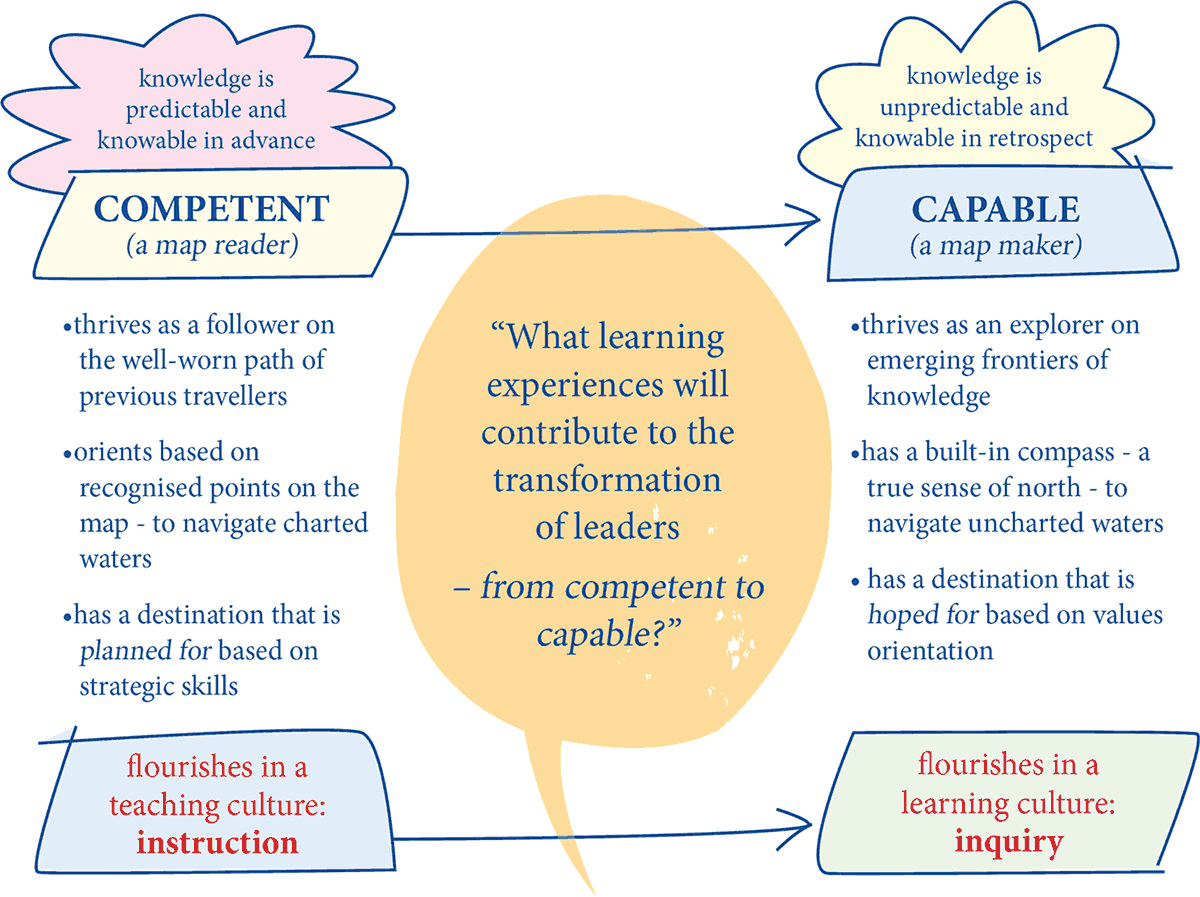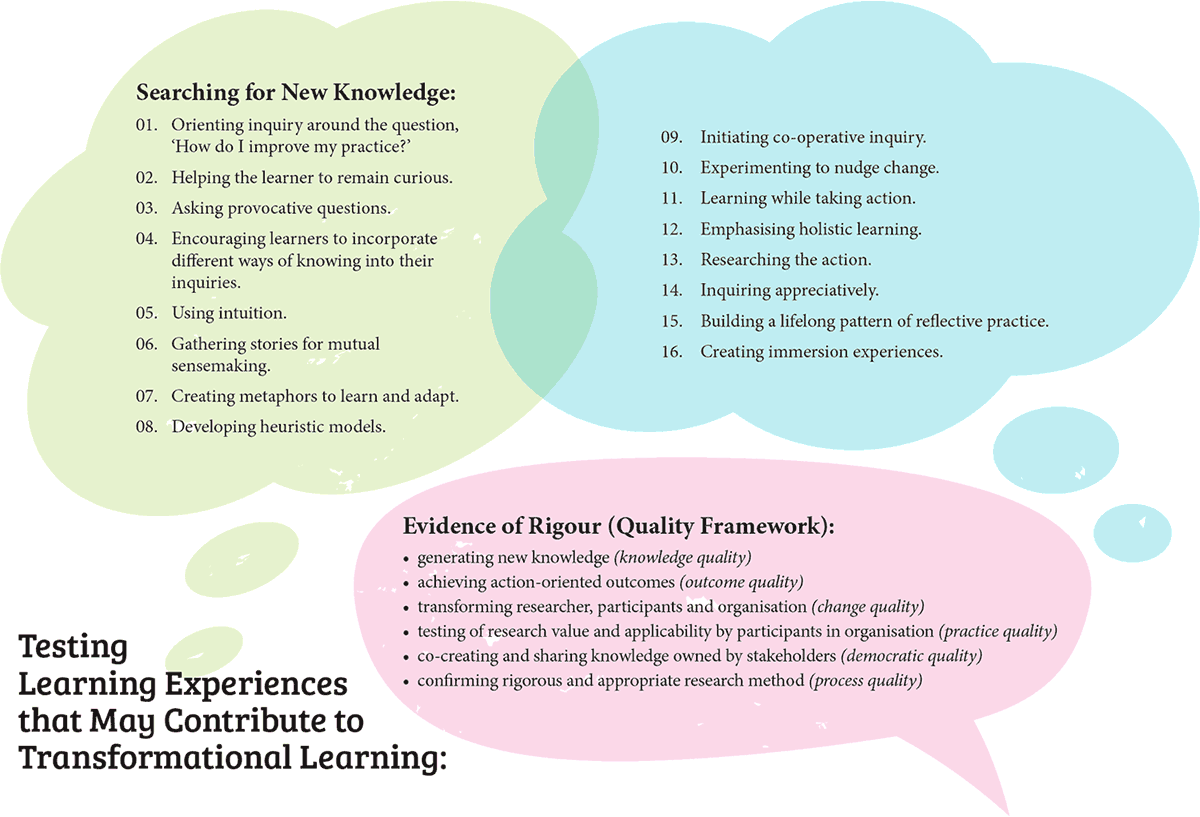The growing understanding of complexity in medicine has pushed the profession from learning for competence (what individuals know or do in terms of skills and knowledge) into learning for capability (individuals adapting to change and generating new, useful knowledge for improved practice). Essentially, capability is a holistic attribute; it is more than competence. While the two ideas can be used interchangeably, they are used hierarchically here. Competence is about being trained to have the skills to do a job. Capability is about knowing what jobs to do. Capable people know how to learn and can apply competencies to new and unfamiliar situations. Capability is the inner resources that people use to learn and adapt to the challenges they face.
Smith (2012) found that competency may be enough in simple environments where knowledge is predictable and knowable in advance. In this context, the learner follows the well-worn path of those who have gone before. Experts know the way forward and students can benchmark their progress like points on a map to reach the desired, and clearly known, destination. As long as the leader knows how to read and interpret the map, the arrival at a predetermined destination is almost inevitable because the risk of variables is diminished by the past practice of those who have gone before. The competent leader flourishes in a learning culture that values instruction.
In contrast, capable leaders thrive as explorers. Navigating in uncharted waters and making their own maps—where knowledge is unpredictable and only knowable in retrospect—requires capable leaders who navigate the unknown with an internal compass, hoping for a destination that is valued but is yet only imagined. Capable leaders flourish in a learning culture that values inquiry. This is shown in diagram 1.

Diagram 1. Moving from competence to capability
Capable leaders intuitively generate their own personal theories of practice. In sense-making, they observe what they do and reflect on it. They will gather data, challenge assumptions, create new theories and generate evidence to support their claims, which will be tested for validity through the critical analysis of others. In short, they make sense of what they are doing through inquiry for both personal and organisational transformation. This is not merely about acquiring knowledge; it is a process in which we make and remake ourselves as whole people.
What Does Transformational Learning Look Like?
In the literature, transformative learning requires a personal journey that includes: (1) the introduction of challenging ideas—a ‘disorienting dilemma’ (Mezirow & Taylor 2009 p. 19); (2) testing taken-for-granted assumptions; (3) self-examination; (4) awareness of a gap in knowledge and/or behaviour; and (5) an integration of new knowledge (cognitive, behavioural and affective) into their whole-of-life. For each learner, this process is emergent and personal.
Smith and O’Flynn (2012 p. 227) asked: ‘what learning experiences may contribute to the transformation of leaders (from competent to capable)?’ Their research and the review of the literature relating to complexity theory (Axelrod & Cohen, 2000; Prahalad & Ramaswamy, 2004; Scharmer, 2009; Senge 1990; Senge et.al., 2004; Snowden & Boone, 2007; Stacey, 2003; Wadsworth, 2010; Wilson & Holt, 2001; Zimmerman et.al., 1998), identified some learning approaches found effective in deep transformational learning:
1. Orienting inquiry around the question, ‘How do I improve my practice?’
This emphasis grounds theoretical knowledge into learning at work and learning for work. It links theory and practice, as per Lewin’s wellknown adage, ‘There is nothing so practical as a good theory’ (Lewin 1951 p. 169).
2. Helping the learner to remain curious
Staying poised as the learner rather than the expert creates a learning culture conducive to adaptive thinking and behaviour (Sharmer, 2009).
3. Asking provocative questions
Asking questions that challenge basic thinking assumptions and patterns of behaviour (Wadsworth, 2010). Seek the big picture and align small goals with the most significant value priorities. Question the big, undiscussable sacred cows – what Argyris (1990) calls double-loop learning, such as ‘Should this organisation even exist?’
4. Encouraging learners to incorporate different ways of knowing into their inquiries
(a) Experiential knowing—personal perceptions, observations, feelings and intuitions that may be tacit and pre-verbal and embedded in the relationships within the situation. (b) Presentational knowing— participants share their experience (the tacit) with others for mutual learning through exhibits in the form of words, images or multimedia in order to generate sharing and mutual discovery. (c) Propositional knowing— sensemaking is developed into statements, theories and concepts. Challenging these models through rigorous review is vital in order to add depth to the learning. The propositions are carried by exhibits (handouts, guides, reflections and articles) to articulate the learning propositions. (d) Practical knowing—being aware of ways to improve what is being done. It is about competency and skill, which is grounded in know-how (Heron, 1996 pp. 238–239; Heron & Reason, 2008 pp. 199–210, 367).
5. Using intuition
Recognise and record decision-making processes based on deeper experiences and spiritual insights rather than merely gathering measurable data (Scharmer, 2009). Through critical reflection and peer feedback, this recognises and tests the role and process of being a spiritual leader rather than merely an operational manager.
6. Gathering stories for mutual sensemaking
Personal narratives capture the tacit experiences of individuals and group processes; as such, they are powerful datagathering tools (Stacey, 2003). Sharing stories facilitates group sensemaking— especially the responses to stories. These responses may take the form of a reply (a storyteller’s reaction to other stories), an echo (a personal story reflecting the theme in another story), a re-creation (a remoulded version of another person’s story) and/or a reflection (ponderings on deeper meanings or applications). Gathering, recording and sharing stories can significantly contribute to the co-creation of new knowledge for improved practice. Lave and Wenger (1991) described stories as ‘packages of situated knowledge’ (p. 108) and cited examples of the power of stories in Alcoholics Anonymous, saying that ‘talk is a central medium of transformation’ (p. 85). The role of stories in sense-making has been given considerable attention by researchers such as Weick (1995), who observed that ‘telling stories about remarkable experiences is one of the ways in which people try to make the unexpected expectable, hence manageable’ (p. 127).
7. Creating metaphors to learn and adapt
Common language, stories and images help to create shared meanings. By clothing their intuition in metaphors, students are able to make sense of the reality they are experiencing and thus build collaborative behaviours to enhance deep change (Axelrod & Cohen, 2000).
8. Developing heuristic models
Gathering ideas in the form of ‘rule of thumb’ diagrams (developed individually or in groups using whiteboards or collaborative technologies) to further ignite sensemaking discussions and develop deeper group understanding (Wadsworth, 2010). Theoretical models can become a toolkit for individual and organisational transformation, as ideas are used, discussed and tested repeatedly by practitioners (Smith, 2012).
9. Initiating co-operative inquiry
A way of group learning that can bring about organisational transformation. Change management efforts are more effective when participants co-create change (Prahalad & Ramaswamy, 2004). Co-operative inquiry is not research about people; rather, it is research with people. All participants collaborate on a research challenge to engage in the design, management, experience, observation and analysis of the project as co-researchers.
10. Experimenting to nudge change
Testing, trying and piloting are all ways to explore what might work and what might not. Small, well-focused actions can produce a ripple effect (leverage) that may produce enduring improvements. If it works, do more of it; if it does not work, stop doing it (Snowden & Boone, 2007; Wilson & Holt, 2001), as failure is merely data for learning.
11. Learning while taking action
Action learning is a process of collaborative transformation in which members of a social system transform themselves and their organisation (Passfield, 1996) through iterative cycles of planning, acting, observing and reflecting. Each cycle of inquiry-driven action leads to enriched human encounters that shape conceptual models that can inform improved professional practice (Heron & Reason, 2008).
12. Emphasising holistic learning
This is more about being than doing. The whole person is engaged—head (cognitive, thinking), heart (emotional, feeling) and hands (physical, doing)—and he or she learns to wholeheartedly pursue his or her vocational interests and be fully absorbed in the learning journey.
13. Researching the action
Action research is a disciplined inquiry process designed to improve professional practice conducted by and for those undertaking the action (Burns, 2010; Goff et.al., 2001). The approach researches reality in order to transform it (Fals Borda, 1979) and equally transforms reality in order to research it Kemmis, 2008). Action research is an effective approach to transformational learning (McNiff & Whitehead, 2010; Smith, 2012) because it requires three areas of development from the researcher when conducting his or her inquiry: (1) theoretical development (making a contribution to the body of knowledge); (2) organisational development (improving professional practice at work); and (3) personal development (being personally transformed in the process).
14. Inquiring appreciatively
A method of generating theory and improving practice by asking positive questions, seeking and sharing success stories, collaborating to identify exemplars of positive behaviours and values (Cooperrider & Srivastva, 1987), and seeking to orient around ‘telling it like it might become’ rather than ‘telling it like it is’ (Gergen & Thatchenkery, 1996 p. 370).
15. Building a lifelong pattern of reflective practice
A way of recording, sharing and verifying real-world data, particularly as reflection-onaction, which focuses on the past (Schon, 1983), reflection-in-action, which focuses on the present (Schon, 1983), and reflection-for-action, which focuses on the future (Killion & Todnem, 1991).
16. Creating immersion experiences
Mezirow’s early work on transformative learning highlighted the importance of a ‘disorienting dilemma’ as a catalyst for a student beginning a transformational journey (Mezirow, 1991). Immersion experiences such as mission trips, study tours, field placements, walking where Jesus walked, sleeping with the homeless, working with the disadvantaged, volunteering as a ministry intern and starting a new ministry are a few of the possibilities for holistic learning in which the student’s entrenched worldview is radically challenged.
A high standard of academic rigour is required in this kind of holistic learning (Lincoln & Guba, 1989). It is a vehicle through which the tacit must be made explicit and students are expected to generate their own contributions to theory to improve their practice. Smith suggested a quality framework (diagram 2) for testing rigour in this kind of inquiry (Smith, 2012), where the learner is required to produce evidence of:
- generating new knowledge (knowledge quality)
- achieving action-oriented outcomes (outcome quality)
- transforming researcher, participants and organisation (change quality)
- testing of research value and applicability by participants in organisation (practice quality)
- co-creating and sharing knowledge owned by stakeholders (democratic quality)
- confirming rigorous and appropriate research method (process quality)

Diagram 2. Learning Experiences
 https://colloquiumgroup.com/wp-content/uploads/2022/11/1181712.jpg
1000
1500
Stephen Smith
https://colloquiumgroup.com/wp-content/uploads/2019/12/the-colloquium-group-logo1-1.svg
Stephen Smith2022-11-17 12:49:212024-02-03 14:09:16Tool: Fostering a trusting team
https://colloquiumgroup.com/wp-content/uploads/2022/11/1181712.jpg
1000
1500
Stephen Smith
https://colloquiumgroup.com/wp-content/uploads/2019/12/the-colloquium-group-logo1-1.svg
Stephen Smith2022-11-17 12:49:212024-02-03 14:09:16Tool: Fostering a trusting team https://colloquiumgroup.com/wp-content/uploads/2022/11/1181712.jpg
1000
1500
Stephen Smith
https://colloquiumgroup.com/wp-content/uploads/2019/12/the-colloquium-group-logo1-1.svg
Stephen Smith2022-11-17 12:49:212024-02-03 14:09:16Tool: Fostering a trusting team
https://colloquiumgroup.com/wp-content/uploads/2022/11/1181712.jpg
1000
1500
Stephen Smith
https://colloquiumgroup.com/wp-content/uploads/2019/12/the-colloquium-group-logo1-1.svg
Stephen Smith2022-11-17 12:49:212024-02-03 14:09:16Tool: Fostering a trusting team

